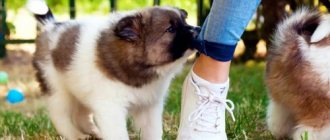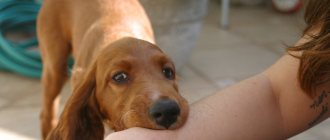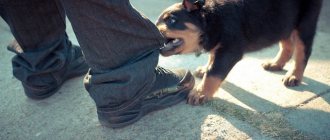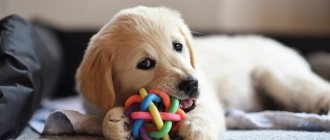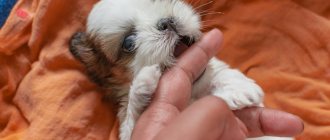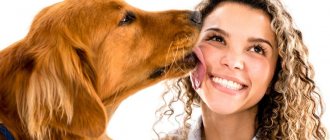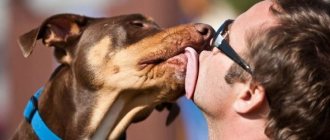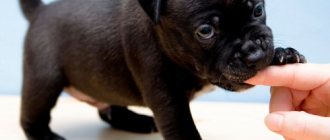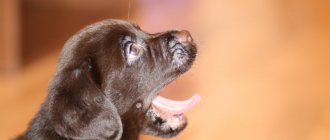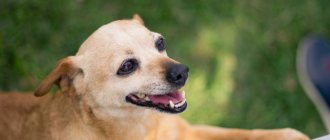Having a dog in your home is not only a great joy, but also a responsibility. To ensure that communication with your pet brings only pleasure, it is important to carefully think through the model of upbringing and study the characteristics of these animals and their needs. One of the most common problems for novice owners is that the puppy bites everything around. In the early stages, such behavior may be associated with the eruption of permanent teeth and exploration of the outside world. If handled incorrectly, this can lead to damage to items and injury in the future. In this article we will look at how to properly train a puppy to stop biting.
Why does a puppy bite?
The desire to bite in puppies is a natural process that is observed in almost all breeds before they begin to grow up. There are several reasons why small dogs actively use their teeth:
- Exploring the World . It is with the help of the oral cavity that puppies explore the world around them. This is how they identify interesting objects, food and establish boundaries allowed by the owner in the new territory. This behavior is especially common when the puppy is brought to a new home.
- Teething . The active process of replacing baby teeth begins at two months and can last 10 months. For a dog, this is accompanied by itching and sore gums, so the puppy begins to bite everything around.
- Communication . If your pet begins to bite your arms or legs, most likely he wants to communicate or play. This behavior is most often observed in dogs that were weaned early from their mother and litter.
- Instincts. The desire to bite everything around can be caused by the dog's hunting instinct. This is especially common in working breeds - dachshunds, terriers, spaniels, beagles.
Uncontrolled use of teeth is observed when dogs express emotions. For example, a puppy actively bites when he is happy or worried. In young male dogs (even before puberty), such behavior may be a sign of a dominant or territorial instinct.
How to stop a dog from growling at its owner: re-education
First, find out the reason. If there are no diseases, learn the basics of training, the nuances of proper food delivery and the benefits of playing together. With their help, you can retrain not only a puppy, but also an adult dog. All you have to do is be patient and not back down.
Serving food
Give out food on a schedule and only after the owners have eaten. This approach will help get rid of not only aggression, but also begging.
Walks and joint games
When raising children, it is very important not to forget about spending time together. Excessive lisp undermines authority, and inappropriate lisp causes discomfort. It is better to gain the trust and love of your pet through walks and games. Both allow you to throw out accumulated energy and consolidate basic commands.
The game form of training creates internal motivation. A dog that enjoys the process learns skills faster and is more devoted to its owners.
Affectionate attitude
Affection needs to be dosed. Excessive affection is perceived by four-legged animals as a form of submission. For this reason, praise and appreciative strokes are recommended as reinforcement tools.
Correct punishment
Effective training does not come without punishment. You should not be afraid of them, as when used appropriately they give very good results. Use them when you ignore commands or perform unwanted actions.
Proper punishment involves the use of a certain intonation that contains a threat. Say the commands “No”, “Ew” or “Bad” in a menacing and harsh voice. Don't scream. Animals are good at detecting changes in intonation and easily distinguish threats from orders and affection.
Breed predisposition
Some breeds are more likely to bite than others. As a rule, such behavior is expressed in large working dogs: husky, German shepherd, Alabai. It is believed that this is due to the animal’s genetic memory, the mother’s behavior pattern, temperament and the need for systematic exercise.
Dogs with a powerful jaw, for example, Rottweiler, Pitbull and Staff, must undergo correction from puppyhood.
This will avoid problems in the future - an uncontrollable dog is a huge threat to others.
Even if the puppy is small, you should not develop a love for biting. Even small teeth can cause a lot of problems. Popular breeds in this group:
- Jack Russell Terrier;
- Toy Terrier;
- French Bulldog;
- pug;
- chihuahua;
- Pomeranian Spitz.
If you cannot cope with raising your pet, regardless of the size of the animal, you should contact a professional dog trainer. He will select the most appropriate behavior model, taking into account the characteristics of the breed and the dog’s temperament.
When should you contact a specialist?
The help of a specialist is necessary when identifying attacks of pain, unmotivated aggression and prolonged lack of results from training. Depending on the situation, you will need:
- Vet. After diagnosis, he will help you get rid of the problem with the help of suitable treatment. If physiological health is in order, the four-legged patient will be registered with a zoopsychologist.
- Animal psychologist. This specialist studies animal behavior and cause-and-effect relationships. In most cases, unreasonable growling has an explanation, but it is difficult to identify on your own. In such a situation, drug treatment is resorted to only when mental disorders are confirmed.
- Dog handler. Classes with a dog handler always give results. A competent specialist can cope with even a very problematic dog. All you have to do is choose the form of classes: group or individual.
If you have successfully mastered the basics, but want to achieve more, sign up for special courses. Completing OKD and ZKS will improve the discipline of your four-legged pet, and joint agility classes will strengthen your bond.
Correction during the game
Raising a puppy is best done while playing. This allows you to avoid the animal’s negative emotions - the necessary skills are reinforced by the pet’s positive experiences. The easiest way to deal with a dog biting his legs or arms is to put a ball in his mouth at the beginning of the movement. Alternative methods and useful recommendations:
- Try to avoid positive reinforcement for careless play. If your puppy begins to bite while interacting with you, you should immediately respond to his behavior. In this way, let your pet know that the game is a reward for good behavior.
- If the puppy begins to behave too actively during interaction or play, biting, stop the contact, turn his head to the side and cross his arms over his chest. Continue the game only after the dog has calmed down.
- Say “ouch” or “that hurts” loudly when the puppy lunges to bite you. An alternative is to use a squeaky toy.
Any correction should be gradual. First, you need to demonstrate your reaction only to strong bites, then avoid even accidental biting.
Preventive measures
To avoid having to wean the dog off biting in the future, you need to immediately put the animal in its place and apply preventive measures. Here are some of them:
- Do not allow your four-legged dog to sleep on your bed. The dog must sleep in the place allocated to him, which is located below the bed of the “pack leader”.
- Never let the tailed one go out and enter the apartment first, or walk up the stairs ahead of you. The “leader” should go first.
- If you are walking on the street and the path you are walking on with your pet is too narrow, do not give way to the dog. Walk along it yourself; your pet can walk along the side of the road.
- Try to eat your own food before feeding your dog.
- Prepare and serve food to your dog so that he can see that the food is not coming from nowhere. The dog must see that what he receives is given to him by the owner.
- If you command your pet any command, be sure to wait for the four-legged dog to execute it, even if it takes a long time.
Switching attention
Puppies quickly switch from one object or action to another. This can be used to stop your dog from biting you. The optimal solution is to use a toy. If your pet begins to show his teeth, take the toy in your hand and then throw it to the side. Various whistles or moving objects can be used. When performing the desired action, be sure to reward the animal with a treat.
Hand Punishment
This method is considered the most natural for dogs, but it is important to correctly calculate the force - excessive impact can cause negative emotions in the pet, aggression towards you, and even health problems. You can't hit the dog, but you can use your hands in the following ways:
- lightly flick the nose or ears;
- pinch the side or croup area, simulating a bite;
- pull the skin on the withers to the side.
Such manipulations cannot be enhanced by emotions - they must be performed only technically, without shouting or raising the voice. It is important that the dog understands why he received the punishment - the impact should be immediately after he begins to bite you.
Let me calm down
If your dog has already mastered simple restraint commands - “stand”, “lie down” and “sit”, they should be used to correct behavior. When the puppy got carried away during the game and began to rage, bite you, say the desired command. Be sure to achieve compliance and then give a treat. In the future, such behavior can be stopped by sending it to a place if the apartment has a sunbed and the pet knows the “place” command.
General Remedies
There are no universal ways to wean a dog from aggression. The owner needs to look for an individual approach in each case, and together with the dog handler.
But there are general tips for correcting behavior:
- identify why anger arose and eliminate its source;
- exclude possible diseases;
- do not beat, humiliate, punish or yell at your pet;
- establish leadership;
- encourage kindness and obedience.
Children should be taught the rules of behavior around animals as early as possible. They must treat the dogs kindly and approach and pet them only with the permission of adults.
Separately, there are medicinal methods that can help remove aggression.
The first is taking sedatives. They relieve increased excitability and anxiety, and facilitate behavior correction.
The second includes castration. The method is used when a dog shows competitive, social, or sexual aggression. Moreover, the method works better with male dogs - their androgen levels drop after surgery.
In bitches, the level of hormones remains almost unchanged, so sterilization is effective only during estrus or false pregnancy.
Working with aggressive dogs
When raising temperamental and dominant dogs, gentle methods of positive influence do not always give the desired result. In this case, it is recommended to move on to physical training techniques. Effective ways:
- Press to the floor. One of the most effective and safest ways to influence a dog. As soon as the pet begins to aggressively growl and bare its teeth, take it by the withers and press it to the ground. Hold persistently until the animal calms down. All manipulations must be carried out smoothly and without emotions in order to avoid negative consequences. After calming down, talk to your pet and give him a treat.
- Turn over onto your back. The technique is similar in its mechanism of action, the only difference is that the dog needs to be turned upside down. If it is not possible to place the puppy on its back, it can be placed on its side.
- Lift into the air. Recommended for very active and temperamental puppies that cannot calm down for a long time and continue to bite even after your commands. After your pet touches you with its teeth, gently grab your chest and lift it so that its paws leave the ground. Wait a few seconds, then release and, after the condition has normalized, reward for calm behavior.
Any dog, regardless of size and character, must unconditionally obey its owner and respond to commands. If you are unable to find the correct correction technique, you should contact a dog trainer. For some puppies, it will be useful to take PKS (protective guard service) courses - this will allow you to realize the potential of your animal without a detrimental effect on its psyche. You can start them as early as 3 months.
In addition, even regular group obedience classes are effective in teaching a puppy not to bite constantly - at an early age, dogs try to imitate the behavior of other individuals, so it is better to train surrounded by adult, trained animals.
Causes of aggression
There are 4 fundamental reasons why an animal can show aggression and growl at the owner.
- This list includes animal breeding that was poorly planned, in other words, not thought out at all.
- Also, a dog can grumble due to improper upbringing, aggression towards it, violence from a person, constant bullying (intentional provocation of evil).
- Another reason is the intrusiveness of children or guests (friends of the owner). A man's friend simply cannot calm down, because she is disturbed day and night. This is where aggressive signs and growling arise.
- It is necessary to highlight incorrectly carried out or late socialization, due to which the pet cannot adequately respond to other animals or people.
It is important to understand that aggression, as well as attachment, refers to the emotions of an animal. It is forbidden to proceed only from facts; you need to know your dog, feel its mood, listen to your own intuition. Wisdom, empiricism and kindness are your best allies. Of course, a dog’s emotionality should not be discounted.
How not to unlearn - common mistakes
When correcting behavior, it is easy to make mistakes, which can lead to changes in your pet’s psyche - puppies are distinguished by their receptivity and mobility of emotions. Typical mistakes when working with dogs at an early age:
- You cannot respond with any emotions to the excitement of the animal. Even positive reinforcement and affection can harm correction. All your reactions should be calm and thoughtful. If the puppy ignores the command, then wait for a reaction.
- It is forbidden to shout or hit the puppy, even if it bites painfully. This can only lead to increased aggression, the development of anxiety and nervousness.
- The puppy should not play with your things or bite your shoes or other objects. As soon as you notice that the dog has begun to tinker with an unwanted object and is gnawing on it, stop this behavior immediately.
- It is forbidden to punish the puppy with food or walking. All basic needs must be fulfilled in full (even if it is not obeyed at all), since the future health of the dog depends on this.
Peculiarities of upbringing directly depend on the puppy’s temperament and the characteristics of the breed. When working with excitable puppies, play, praise, and even voice changes should be limited. You should pay attention to what the puppy responds to better and what it can ignore altogether, change the strategy taking into account the character of your pet.
Statistical data
- Let's give other facts and study statistics. Dogs have been living close to people for many centuries. Such long-term cooperation has led to the fate of animals and humans getting along without conflict. Cynology, an abyss of wisdom about dogs, has moved forward.
- Dogs are under close supervision of scientists who reveal completely new and new features of their four-legged friends. Thanks to the extensive experience of dog handlers, their cooperation with trainers and amateur dog breeders, we were lucky enough to draw conclusions regarding the behavior of dogs.
- According to statistics, approximately 78% of pets that growl at their owners or maybe in another way show aggression towards a person, even if they bite the owner himself or members of his family. This percentage does not apply to the fact that cattle bite intentionally. The actions of people could have prompted him to do this. But a fact is a fact.
- According to some data, more than 60% of people injured by dogs are the owners of the animals themselves. Moreover, of the indicated percentage, most of the people are the old guard or small children. When a dog attacks a child, its bites occur on the facial tissue. This is dangerous, so measures must be taken.
- As for the upbringing and maintenance of aggressive animals, they were attacked mainly by aunts who were kept at home or were thrown out onto the streets for unknown reasons. In any case, a sausage raised by a person is more aggressive. Than the one who was born on the street and was raised by a bitch.
Briefly about the main thing
- Puppies can bite due to teething, while exploring the world around them and in the process of communicating and playing with the owner.
- Some breeds are prone to biting. This is important to consider when choosing a parenting strategy.
- You can wean your pet off from biting during play, by switching attention, or by ignoring it.
- For aggressive and temperamental dogs, stronger methods should be used - physical impact, punishment.
Have you ever experienced that your puppy started biting? Share in the comments how you dealt with this problem.
Cool photos
If a person cannot teach a puppy to bite on their own, then it is imperative to seek help from a dog handler. You should not refuse to train your dog if it is a smaller breed. Experts recommend observing the behavior of puppies and their mother. They claim that she herself can correct the behavior of children by teaching them to behave well.
Whenever you get another bite from a domestic woolly crocodile, breathe deeply and remind yourself: this period will end one day
